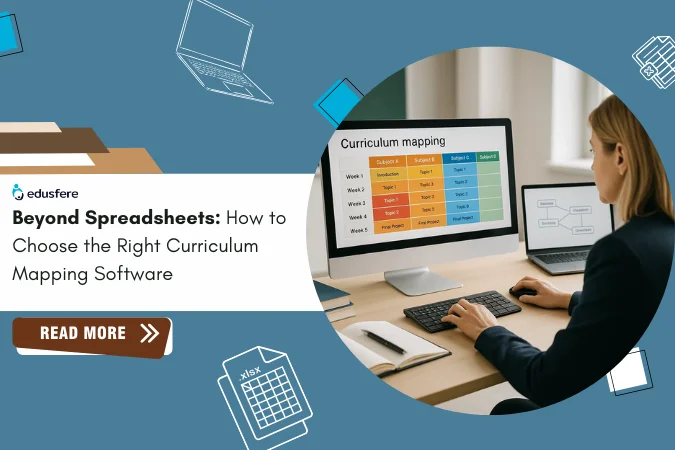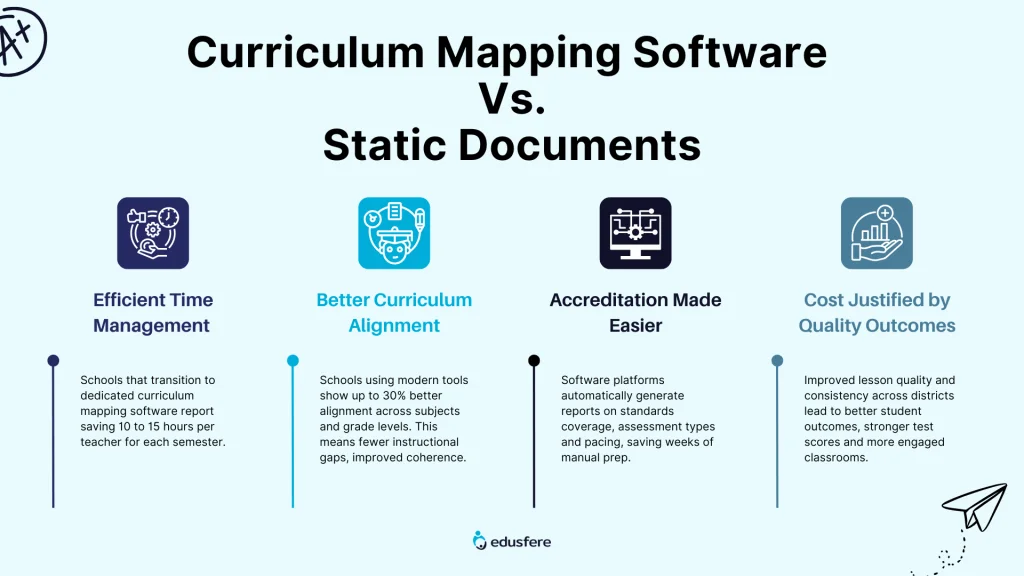Schedule a free demo to learn more
Beyond Spreadsheets: How to Choose the Right Curriculum Mapping Software for Your School
3 June, 2025

In a world where digital transformation is sweeping through every sector, it’s surprising how many schools still rely on static spreadsheets and documents for curriculum management.
These traditional methods may feel familiar, but they no longer meet the complex demands of modern-day teaching. For tech coordinators, superintendents and curriculum directors, it’s time to enable the move beyond spreadsheets. Especially with the back-to-school season on the horizon.
Today’s blog will help you understand why traditional spreadsheets are no longer enough, what to look for in modern curriculum mapping software and how to evaluate tools that align with your school’s goals. It also highlights the ROI of moving beyond manual processes, just in time for the back-to-school 2025 planning.
Why Spreadsheets and Static Documents aren’t working anymore
For years, spreadsheets and static curriculum binders have been the default tools for mapping learning objectives, pacing guides and teacher lesson plans. But in today’s fast-evolving K-12 landscape, these tools are no longer meeting the demands of effective curriculum management.
Read more: How are Teachers using Curriculum Mapping to Design more Effective Lessons?
A 2023 report by the EdWeek Research Center found that 72% of curriculum directors struggle to ensure vertical and horizontal alignment across grade levels when using spreadsheets or PDF-based documents. The primary issue? Static tools don’t support real-time collaboration, make cross-grade visibility cumbersome and fail to track adjustments aligned to state standards or evolving school goals. Here’s a quick look at the downsides of using static documents and spreadsheets:
They’re not built for Collaboration
Most curriculum planning happens in teams. Teachers, coaches and administrators work together to align teacher lesson plans with standards. But spreadsheets and Word docs lack real-time collaboration features. This leads to version confusion, miscommunication and endless email threads.
Manual Updates often lead to Manual Errors
Whether it’s pasting in standards or updating scope and sequence, manual data entry in spreadsheets is a breeding ground for inconsistencies and errors. A single outdated cell can ripple across grade levels.
No Visual Mapping or Alignment Tools
Spreadsheets can’t visually display instructional gaps, overlaps or pacing issues across subjects and grade bands. This makes it hard to ensure your curriculum mapping is aligned, equitable and effective.
Difficult to Audit or Track Progress
Version control in spreadsheets is clunky. There’s no way to track historical changes or get an audit trail for compliance and accreditation.
Key Features of a Modern Curriculum Mapping Software
Modern curriculum mapping software is purpose-built to solve these problems. It replaces static documents with dynamic, cloud-based platforms that enhance every aspect of curriculum management.
- Standards-aligned Teacher Lesson Plans
Leading curriculum mapping software in 2025 comes pre-loaded with national and state standards (Common Core, NGSS, state-specific), so teachers can align their lessons with benchmarks in real-time. - Visual Curriculum Maps
Forget cells and tabs. Dynamic platforms offer visual maps showing when and how standards are taught, helping leaders identify instructional gaps or redundancies at a glance. - Embedded Teacher Lesson Plan
Teachers can upload, create and align lesson plans directly within the software. This ensures every instructional minute is intentional and standards-aligned. - Back-to-School Tech Integration 2025 with Real-time Collaboration Tools
Teachers and administrators can comment, edit and review curriculum maps together; just like Google Docs, but smarter. This promotes transparency, shared ownership and pedagogical consistency. - Version Control and Audit Logs
Track every change with automatic version history. This is particularly helpful for accreditation reviews and internal audits. - Role-based Access and Permissions
Give teachers, coaches, principals and district leaders the right level of access, while ensuring data security and clarity of roles.
- Integration with LMS and SIS
Connect your curriculum map with existing platforms like Google Classroom, PowerSchool or Canvas to streamline teacher lesson plans and student data tracking.

ROI of Curriculum Mapping Software vs. Manual Effort
When selecting curriculum mapping software, ROI isn’t just about the budget. It’s about what your school gains in return. From reducing manual workload to driving better instructional outcomes, a well-chosen curriculum mapping platform can deliver measurable impact across multiple dimensions.
Let’s break it down into four key areas: time saved, alignment improved, collaboration enhanced and outcomes elevated.
Efficient Time Management
Schools that transition to dedicated curriculum mapping software report saving 10 to 15 hours per teacher for each semester. That’s time that can be reinvested in instructional planning, professional development or direct student support.
Better Curriculum Alignment
Schools using modern tools show up to 30% better alignment across subjects and grade levels. This means fewer instructional gaps, improved coherence, and more equitable learning opportunities.
Accreditation Made Easier
Whether it’s Cognia, WASC or your state’s accreditation board, curriculum documentation is a cornerstone of success. Software platforms automatically generate reports on standards coverage, assessment types and pacing, saving weeks of manual prep.
Cost Justified by Quality Outcomes
When teachers spend less time wrestling with spreadsheets, they can focus on what really matters, i.e., teaching. Improved lesson quality and consistency across the district lead to better student outcomes, stronger test scores and more engaged classrooms.
Why Curriculum Mapping Deserves a Digital Upgrade
Dr. Heidi Hayes Jacobs, a leading expert in Curriculum Design, has long emphasized that “curriculum must be viewed as a living document,” not something filed away in drawers.
Spreadsheets simply weren’t built to function dynamically, they lack version control, insight dashboards and communication features that help teams reflect, iterate and act on curriculum data.
Moreover, static formats often create silos between administrators and classroom teachers. When curriculum updates are made in isolated files, teachers receive outdated or inconsistent information, undermining instructional coherence. This fragmentation can be particularly damaging during back-to-school 2025 periods when alignment and preparedness are critical.
Read more: The Ultimate Curriculum Mapping Checklist For U.S. K-12 Schools In 2025
From a technical standpoint, spreadsheets also fall short on accessibility and usability. A study by the Consortium for School Networking (CoSN) in 2022 revealed that 45% of edtech leaders cite user frustration with manual tools as a top barrier to curriculum innovation. For schools managing multiple campuses, instructional teams or differentiated programs, the margin for error and duplication increases exponentially.
What schools need now is a shift from reactive documentation to proactive curriculum design. A robust curriculum mapping software empowers teams to visualize curriculum coverage, align lessons to standards, track gaps and update plans in real time. It transforms curriculum from a static task into a collaborative, strategic process that evolves with student needs and institutional priorities.
The back-to-school 2025 season is the perfect time to reimagine how your school or district approaches curriculum. If your team is still relying on spreadsheets, static docs or siloed systems, you’re not just risking inefficiency, you’re potentially compromising instructional quality.
A modern curriculum mapping software platform brings agility, alignment and accountability to your curriculum management process. It connects the dots between standards, teacher lesson plans and student outcomes.
Ready to Move Beyond Spreadsheets?
At Edusfere, we partner with forward-thinking K-12 schools across the U.S. and the globe to simplify and strengthen their curriculum planning. Our platform empowers your team with real-time collaboration, dynamic mapping and compliance-ready documentation, all tailored for K-12 success.
Schedule a demo today and see how our curriculum mapping software can transform your school’s instructional planning, just in time for back-to-school.